When you hear the term “Dorian mode,” it refers to one of the most versatile musical modes that combines the soulful feel of the minor scale with an unexpected brightness.
The Dorian mode is defined by its minor third and major sixth, which gives it a distinct character that feels both moody and uplifting at the same time (pretty cool, right?).
It can add depth to a trap beat, bring groove to a pop melody, and give your EDM chord progressions a unique twist.
As producers, learning all about the Dorian mode can completely transform your skills when it comes to melodies, basslines, and chord progressions.
That’s why we’re breaking down everything you need to know, like:
- The basics of the Dorian mode and what makes it unique ✓
- How to build Dorian scales from any root note ✓
- Key Dorian mode formulas and scale degree breakdowns ✓
- Chord progressions that bring out the Dorian sound ✓
- Tips for writing melodies with the Dorian mode ✓
- Using Dorian harmony in hip-hop and pop tracks ✓
- How the Dorian mode is different from any other mode/minor mode ✓
- Blending Dorian with minor pentatonic for solos ✓
- Creating modal solo sections that stand out ✓
- Minor scale & major scale essentials ✓
- How one octave can change everything ✓
- Advanced sound design ideas with the Dorian mode ✓
- Much more about the Dorian mode/Dorian scale ✓
After reading this article, you’ll know everything about the Dorian mode/Dorian scales and how to use it in your own tracks.
Plus, you’ll learn how to lay down melodies, design chord progressions, Dorian harmonies, and never let your basslines sound boring or basic ever again.
You’ll be able to incorporate a real soulful edge to your tracks and have a real competitive advantage over the competition (plus up your theory skills as well).
So, if you’re ready to master the Dorian mode, let’s dive right in…
Table of Contents
Breaking Down the Dorian Mode
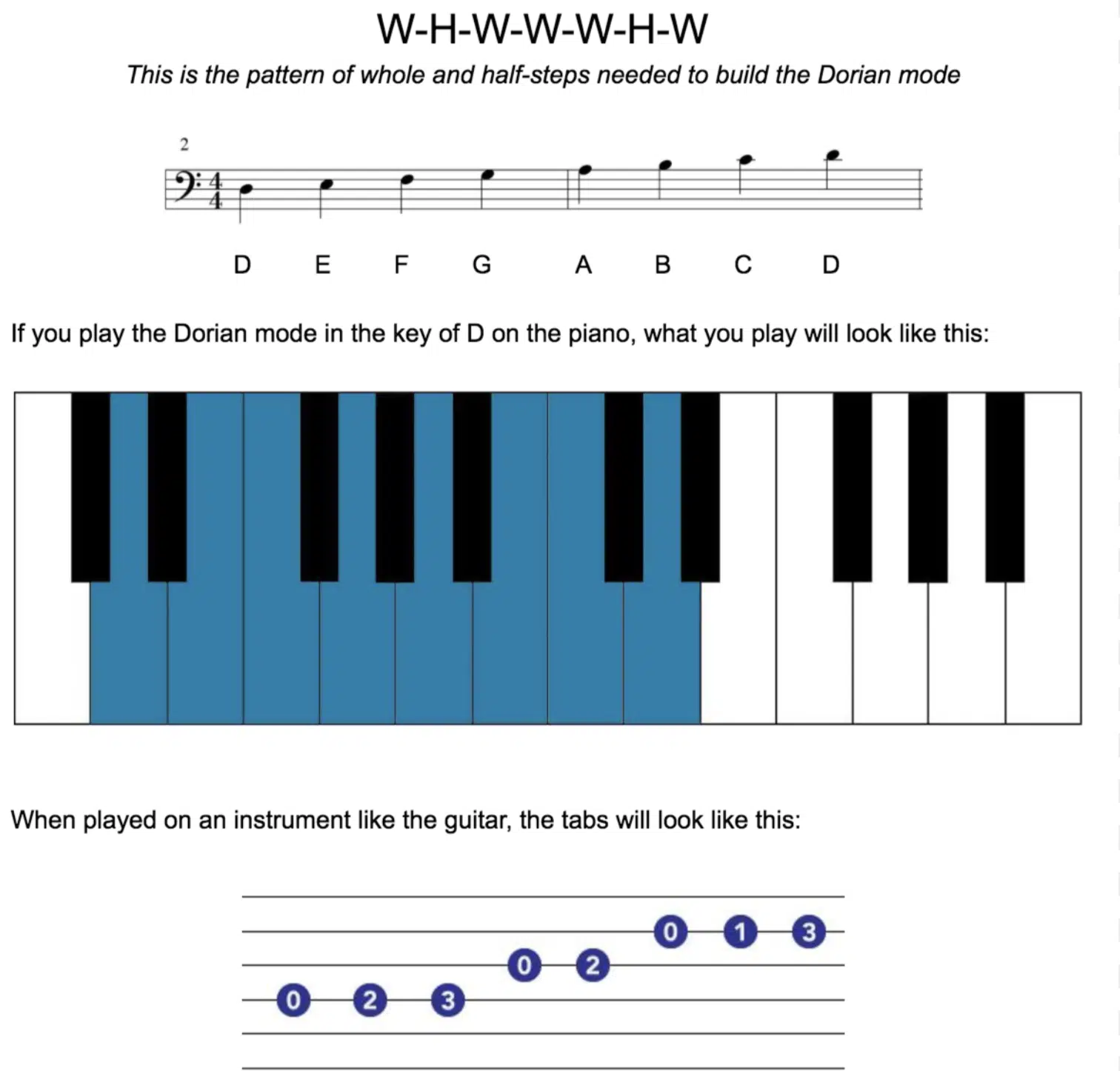
The Dorian mode is a seven-note scale that sits between the major and natural minor scales 一 making it extremely versatile for all genres, styles, and vibes.
It is the second mode of the major scale (Ionian mode) in the system of diatonic modes.
Think of it like a minor scale with an unexpected twist… by raising the sixth note, it brings a hint of brightness to an otherwise minor tonality.
Take the D Dorian scale for instance: the notes D, E, F, G, A, B, C provide a unique blend of minor third (F) and major sixth (B).
This major sixth creates a subtle shift in the Dorian sound, giving it a slightly more uplifting and hopeful feel.
It really works well for a catchy trap melody or a soulful pop chord progression, and everything in between (you can get as creative as you’d like).
The Dorian mode lets you layer minor chords with a little extra brightness, which keeps things fresh in genres that often rely on dark, repetitive loops.
If you’re making EDM, you can use the Dorian mode to balance between sick basslines and melodies that have a bit of an optimistic edge, perfect for building energy in a drop.
Don’t worry, we’ll break down everything you need to know about the Dorian mode so you can really get a solid understanding and start using it in your own music right away.
Understanding the Theory Behind the Dorian Mode
To really master the Dorian mode, it’s important to understand its music theory foundation and how it differs from other musical modes. So, let’s break down the Dorian mode formula and see how you can start using it right away.
-
The Dorian Mode Formula

To build the Dorian mode, start with the major scale of any root note, and then apply this formula/scale pattern:
- Whole step
- Half step
- Whole step
- Whole step
- Whole step
- Half step
- Whole step
For example, if you start on D, the D major scale is D, E, F#, G, A, B, C#.
Now, lower the third and the seventh to F and C respectively, giving you the Dorian scale: D, E, F, G, A, B, C.
This scale pattern makes the Dorian mode distinct… It’s a minor scale but with a major sixth thrown in there so it produces a pretty cool and unique sound.
Just remember that the major sixth (B in the case of D Dorian) is what sets Dorian apart from the Aeolian mode or natural minor.
You can use this Dorian mode formula to create unique melodic lines 一 try applying it to a simple trap beat and add a top melody that revolves around D, F, and B.
Use half-step intervals, especially between E and F or A and B, to emphasize the Dorian mode intervals.
These slight movements give your melodies a smooth, laid-back feel that works well for both pop hooks and EDM breakdowns (plus even more classic genres as well like jazz).
-
Pro Tip
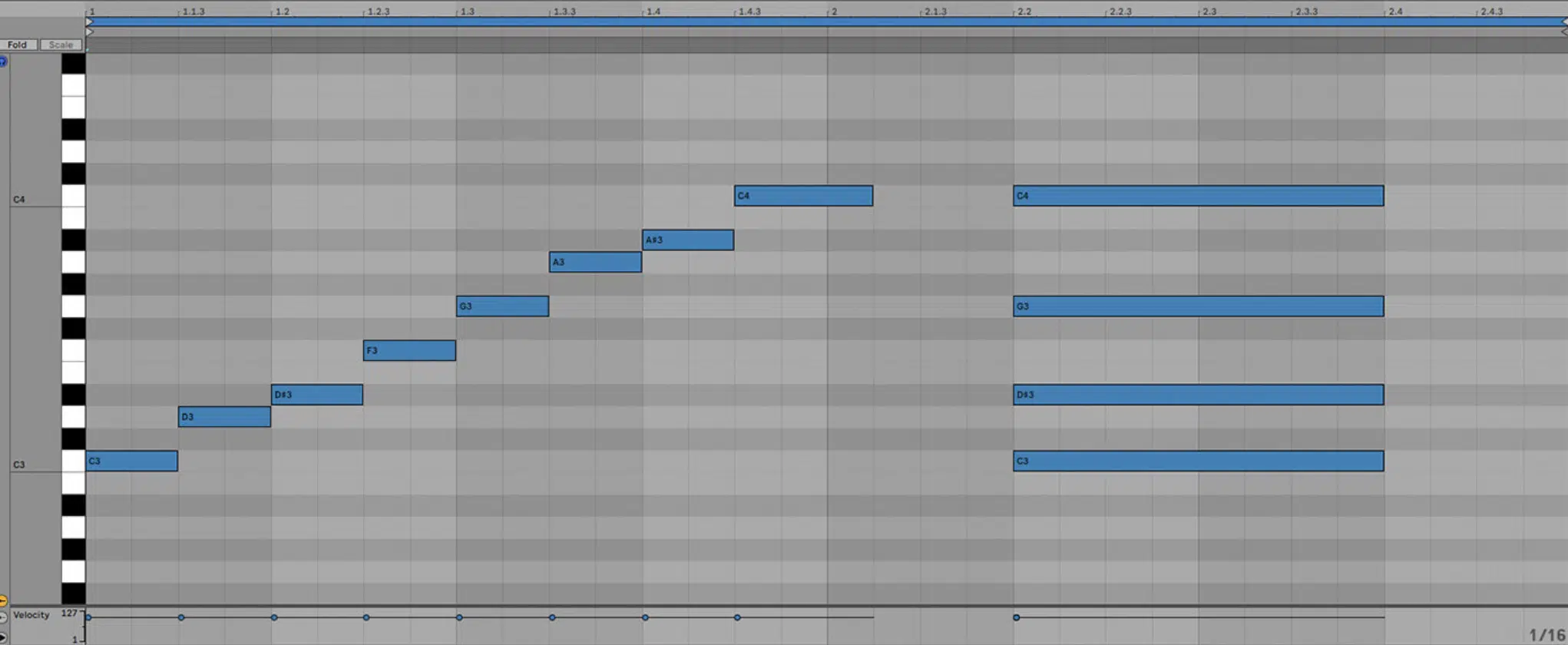
D Dorian Scale in my Piano Roll
When building the Dorian mode, you should pay close attention to the third and sixth scale degrees, because this is where the magic lies.
These scale degrees are key in defining the Dorian sound:
- The third scale degree (minor third) 一 Gives it a minor tonality.
- The sixth scale degree (major sixth) 一 Brightens it up.
In D Dorian, which I’ll be basing most of my examples off of, that’s F as the third scale degree and B as the sixth scale degree.
As you create melodies or chord progressions in Dorian, always emphasize these scale degrees to keep the distinct Dorian mode feel.
This is especially true when working with more modern genres like trap or hip-hop, where mood is everything.
By playing around with the half-step intervals before and after the third and sixth scale degrees, you can add tension and release in your phrasing that really reels people in.
-
Building the Dorian Mode from Any Root Note
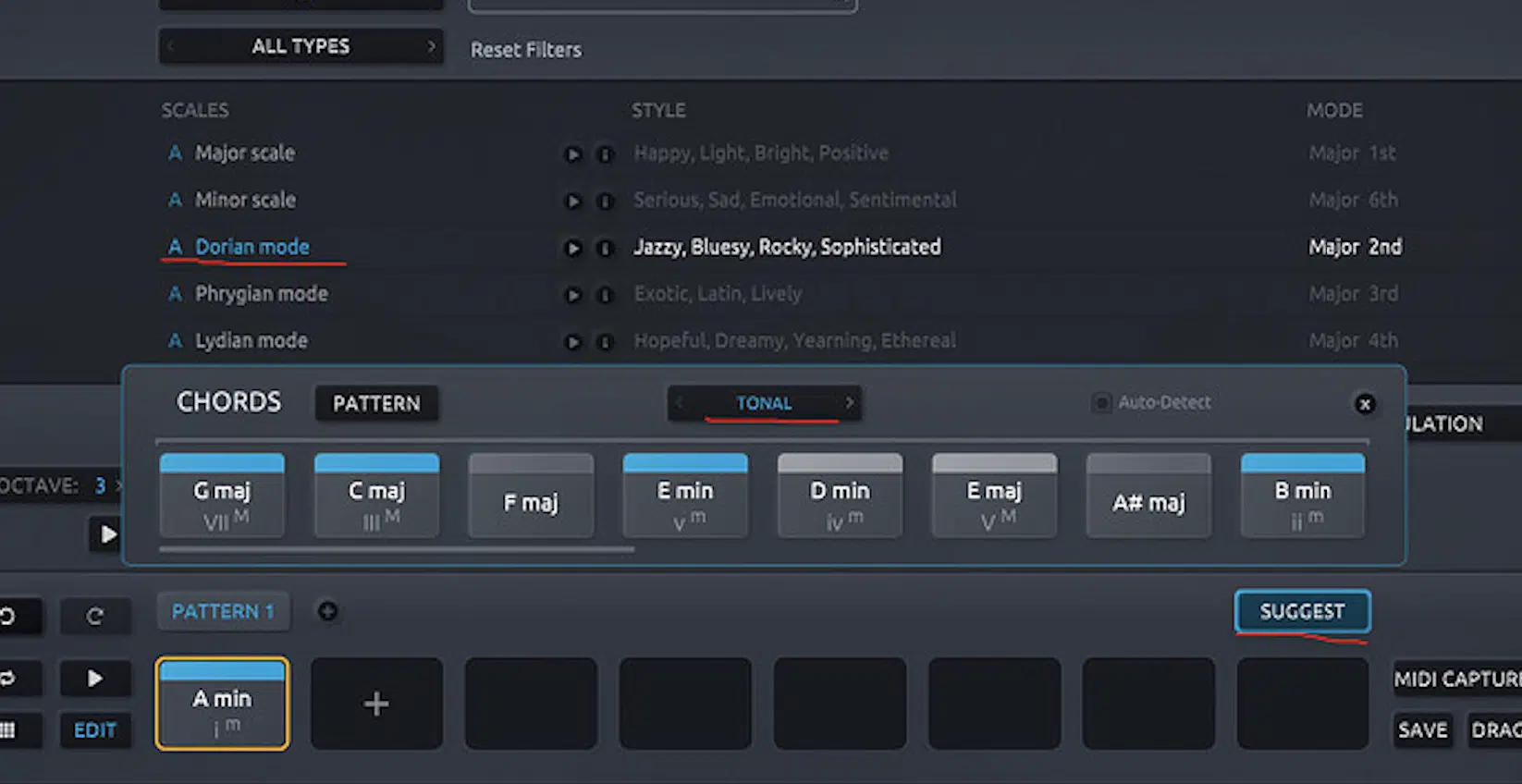
To build the Dorian mode from any root note, start by finding its major scale, and then simply adjust the scale degrees to fit the Dorian scale pattern.
It might sound a little intimidating at first, but it’s fairly easy once you get the hang of it.
Say you’re working in C: the C major scale is C, D, E, F, G, A, B, right? Well, to create the C Dorian scale, simply lower the third and seventh degrees, giving you: C, D, Eb, F, G, A, Bb.
This formula works for any and all root notes and lets you explore Dorian scales in different keys.
Side note, if you’re wondering how to tell what key a song is in, we got you covered.
You can even experiment with the G Dorian scale (G, A, Bb, C, D, E, F), which is especially useful in hip-hop beats.
All you have to do is try laying down a melody that highlights the Bb and E to add a unique vibe and really shows off your skills.
In trap, the C Dorian scale is perfect for more moody 808 basslines, especially when you start on C and use Eb and Bbas accent notes.
If you’re producing EDM, try layering synths on a D Dorian scale for a melody that sits comfortably over a pulsing bass 一 using D, F, and B to maintain a fluid Dorian sound.
-
Unique Qualities of the Dorian Mode (+ Emotional Feel)
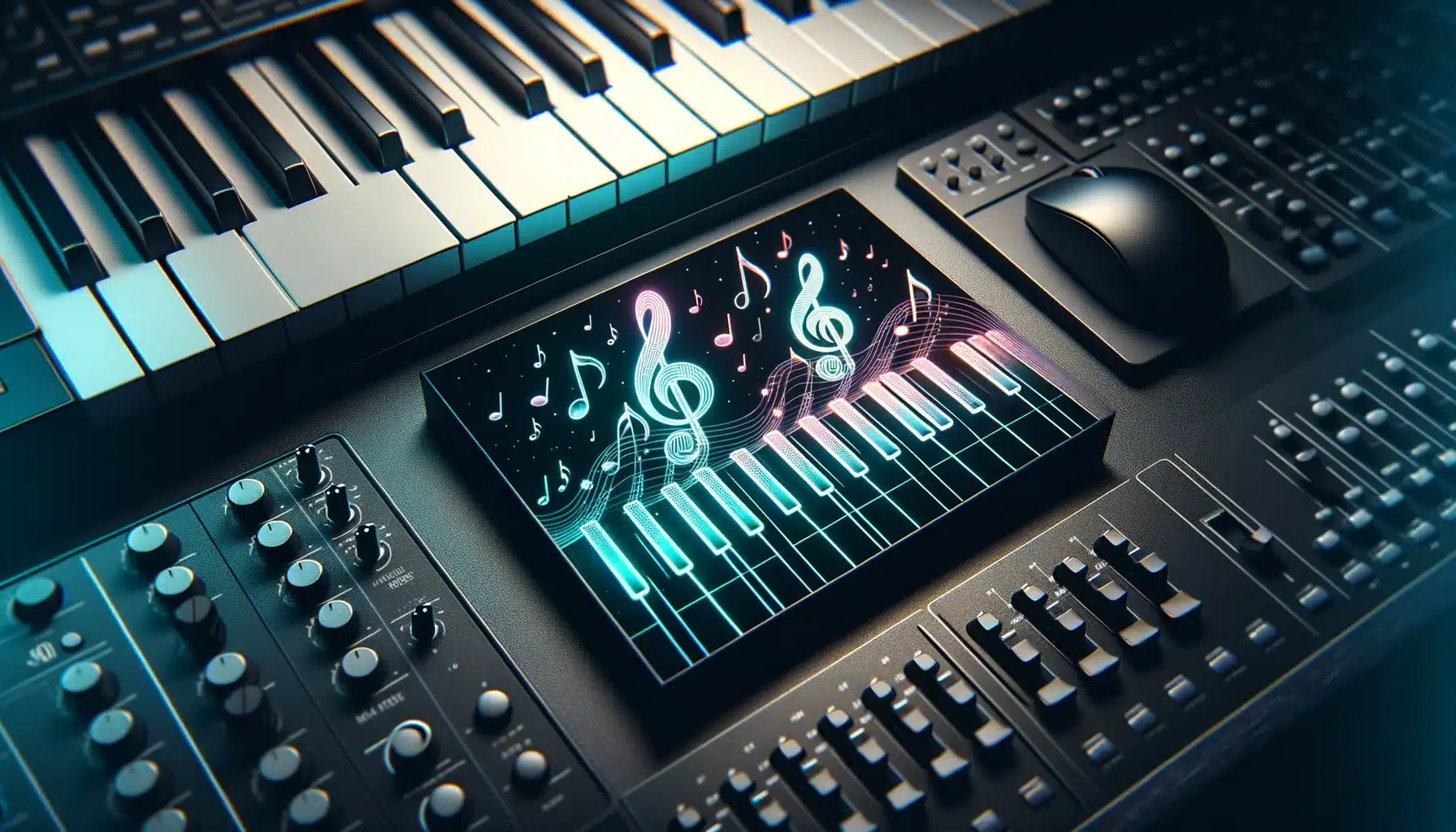
One of the unique aspects of the Dorian mode is its blend of minor tonality with a brighter, almost hopeful quality, thanks to its major sixth.
In this mode, the minor third and major sixth create a distinct emotional feel that’s different from the natural minor scale.
For example, if you’re playing in D Dorian, you have D, E, F, G, A, B, C (a mix of both minor and major characteristics as we talked about earlier).
This hybrid vibe lets the Dorian mode move between dark and light with no issues, which is why you’ll find it so often in funk/jazz where artists need that flexibility.
I know I said this before, but I really need you to remember to emphasize that major sixth when you’re working with the Dorian mode (in D Dorian, that’s the B note).
It gives the scale a lift that other popular minor modes don’t have.
NOTE: When working with Dorian in hip-hop you can build a loop that highlights the major sixth. For example, play a bass pattern that goes D, F, B, A in syncopated rhythms.
By using the B note as a primary landing point, you can create a melody that feels less predictable and has a subtle sense of ‘uplift’ into an otherwise minor groove.
By highlighting the major sixth, you can give your music a less predictable, more uplifting sound that’s ideal for adding groove and soul to your tracks.
The Dorian scale is perfect for when you want to inject a little more brightness into your minor chords without losing that minor flair.
Dorian Mode & Chord Progressions
To really bring out the Dorian mode, you’ve got to try using it in your chord progressions. Let’s go over some basic and advanced Dorian chord progressions that can add depth and versatility to your music.
-
Basic Chord Progression Breakdowns in the Dorian Mode
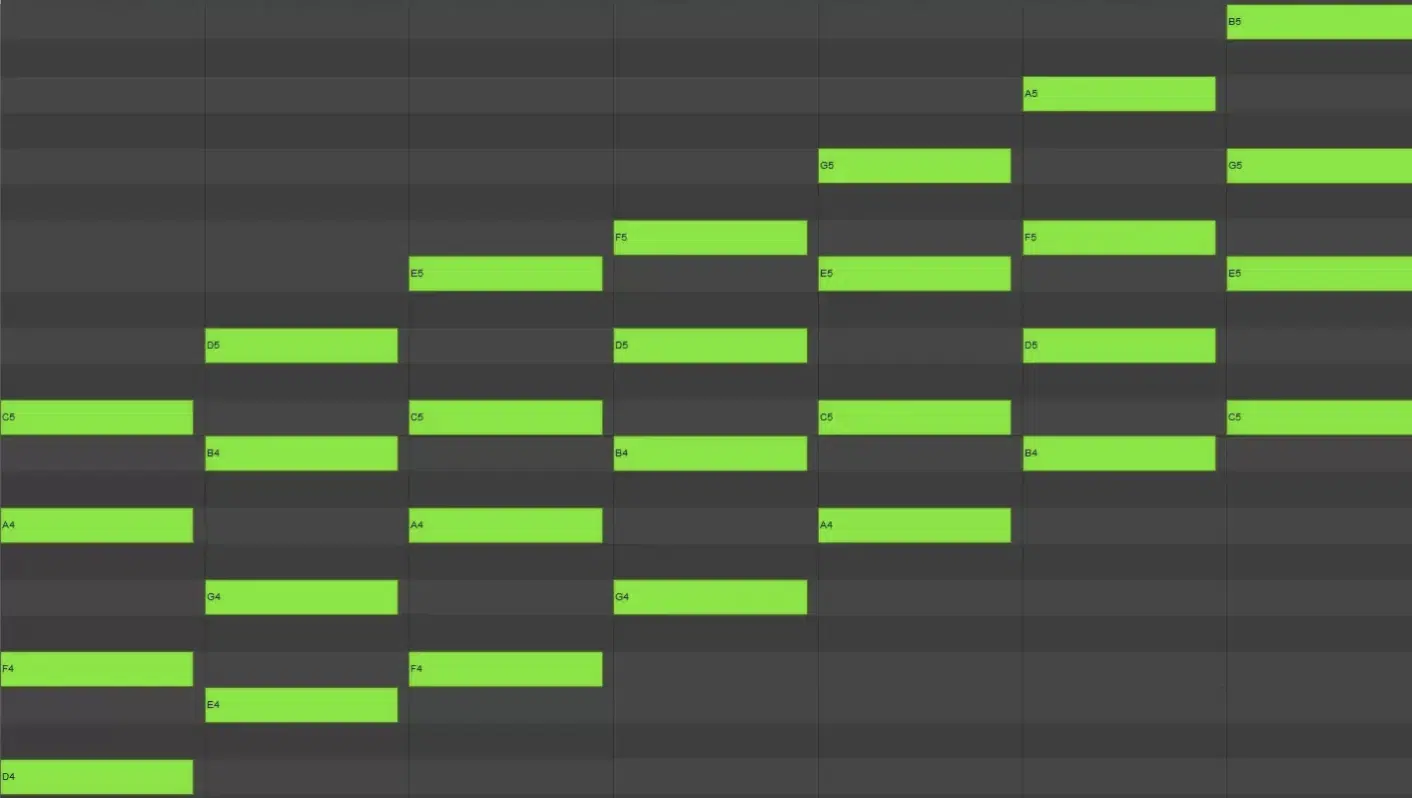
7th Chords in D Dorian
The Dorian mode offers a range of chord progressions that combine both minor and major qualities, making it versatile for genres like pop and EDM.
A classic Dorian mode progression is i – IV (like Dm – G in D Dorian), where the minor chord and major IV create a slight tension.
This works well for pop ballads—try playing Dm – G over a simple beat and layering a vocal melody that emphasizes B to bring out the major sixth.
Another popular option is i – v – IV – i, such as Dm – Am – G – Dm, which is great for hip-hop beats because it lets the major sixth (G) add a bit of brightness to an otherwise minor feel.
In trap, use a i – VII – IV progression, like Dm – C – G in D Dorian, to create a vibe that feels moody yet open.
For EDM, a ii – V progression works well; in D Dorian, you’d play Em – A, which brings out a jazzy, modal flavor that can really build tension before a drop.
To add even more depth, try using a Dorian bassline under these progressions, emphasizing D, F, and B to lock into the Dorian mode feel while keeping your track grounded.
-
Advanced Dorian Chord Progressions

For a more fancy approach, try working with extended chords and modal interchange to develop advanced Dorian chord progressions.
It will seriously help you improve your skills in western music theory altogether.
For example, the ii – V – I progression in D Dorian can be modified to ii – IV – I, which brings out the Dorian sound while using G as the IV chord to reinforce that major sixth.
Another favorite is the i – bVII – IV – i chord progression, where you emphasize the G chord (the IV chord) to add that classic Dorian feel.
It works well in genres that lean on funky grooves or laid-back vibes, like soul and R&B or even some funky hybrids if you’re feeling frisky.
You might also explore minor pentatonic scale shapes within your progressions to blend both minor and Dorian sounds.
If you’re working with a C major scale (C, D, E, F, G, A, B), for instance, start your Dorian mode on D and build out from there using D, E, F, G, A, B, C.
This can be applied to whatever major scale/major scales you’re working with.
For a twist, you can experiment with half-diminished chords in your ii chord to add some tension before resolving back to the i chord.
Combining minor chords and major sixths within a Dorian mode progression can add a lot of harmonic interest and versatility to your music.
Exploring Related Scales and Modes with Dorian
The Dorian mode is linked to several other scales/other modes that can help you expand your melodic and harmonic game. Let’s dive into how the minor pentatonic scale, the natural minor scale, and other popular minor modes relate to the Dorian scales’ sound.
-
The Minor Pentatonic Scale and Its Connection to Dorian
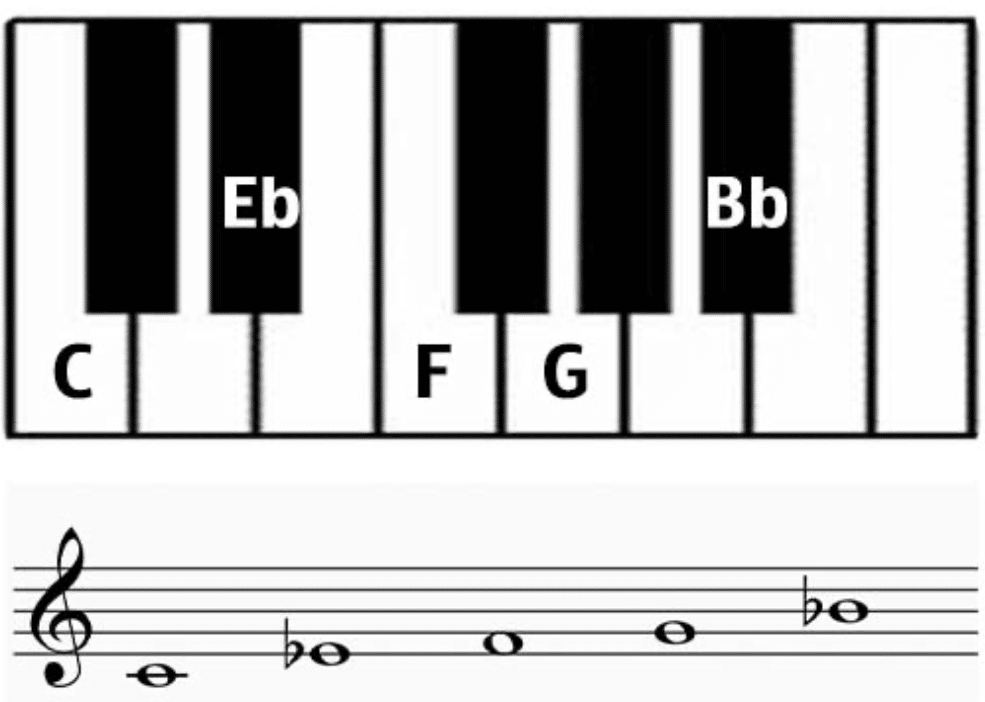
The minor pentatonic scale has a lot in common with the Dorian mode, and the two can be used interchangeably in certain contexts.
For example, if you’re working in D Dorian, the D minor pentatonic scale would consist of D, F, G, A, and C.
Notice how four of these notes (D, F, G, and A) are shared with the Dorian scale 一 making it extremely easy to switch between the two.
This connection allows you to use minor pentatonic scale shapes to add simplicity to a Dorian-mode melody while keeping that minor feel.
NOTE: Use the minor pentatonic when you want a straightforward, bluesy sound, then shift back to the Dorian mode by adding E and B to bring in that major sixth.
You can also create a call-and-response effect by playing a minor pentatonic riff and following it with a Dorian phrase, which adds depth and variety to your music.
This is super useful for solos and improvisation, where blending the Dorian and minor pentatonic scales can create very memorable melodic lines.
The Dorian mode essentially extends the minor pentatonic into a more harmonically rich scale so you have the flexibility to work within a minor tonality with added brightness.
-
Dorian vs. Natural Minor (Aeolian)

When comparing the Dorian mode with the natural minor scale (or Aeolian mode), the primary difference lies in that major sixth.
For example, in D natural minor, the notes are D, E, F, G, A, Bb, C, while in D Dorian, they’re starting note: D, E, F, G, A, B, C.
The only difference here is the sixth note: in Dorian, it’s B; in natural minor, it’s Bb.
This major sixth in Dorian opens up new possibilities 一 letting you introduce major chords like G in a minor context, which you can’t do as naturally in natural minor.
Use the natural minor when you want a darker, more melancholic sound and switch to Dorian for a more hyped-up, versatile feel.
NOTE: Try switching between the Dorian and natural minor scales within the same track to give sections different emotional qualities; it sounds very intriguing.
For example, you could use natural minor for the verse to blow up the minor mode, then shift to Dorian in the chorus to brighten things up without losing the minor foundation.
This contrast can create a compelling dynamic, especially in genres like rock or funk where shifts in mood are impactful.
The Dorian scale keeps the minor feel but adds a unique twist that can elevate your track’s harmonic interest.
-
Interchanging Dorian with Other Minor Modes
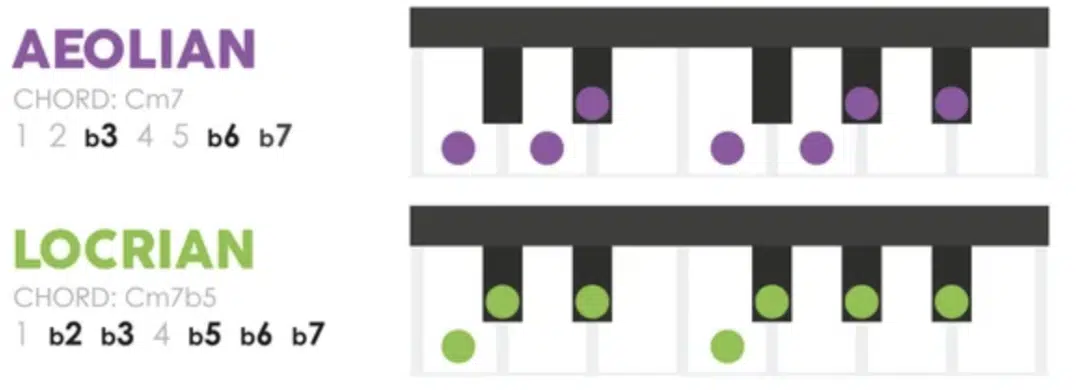
The Dorian mode can work flawlessly with other minor modes as opposed to major scales, allowing you to blend elements of:
- Aeolian
- Phrygian
- Lydian mode
- Locrian
- Etc.
For example, in D Dorian, you could start with D, E, F, G, A, B, C and then switch to D Aeolian by lowering the B to Bb, which introduces a natural minor scale flavor.
This technique lets you shift the emotional feel of a piece without changing the root note 一 providing variety while keeping the same notes overall.
You could also integrate Phrygian into Dorian by lowering the second degree (playing Eb instead of E), which pumps up the minor mode with an exotic/darker edge.
NOTE: Play a Dorian chord progression, like Dm – G – Am – Dm, and then experiment with these modal interchange techniques, transitioning to minor chords from Aeolian or Phrygian within the same scale pattern.
This will keep your track grounded in Dorian while adding harmonic interest.
You could also switch between Dorian and Locrian by lowering the fifth (A to Ab), adding a dissonant touch that stands out in genres like fusion or progressive rock.
This kind of Dorian mode experimentation provides a fresh way to explore the minor tonalities while keeping your music dynamic and engaging.
Expert Tips for Using the Dorian Mode (For Producers)
The Dorian mode offers plenty of opportunities for creativity, whether you’re creating melodies or layering harmonies. So, here are some expert tips on how you can make the most of Dorian in your melodies, harmonic layering, and sound design.
-
Writing Melodies in the Dorian Mode

When writing a melody in the Dorian mode, emphasize the major sixth to bring out its unique sound.
For example, if you’re working with D Dorian (D, E, F, G, A, B, C), try creating a melody that frequently uses D, F, and B.
These notes give a mix of the minor third and major sixth, perfectly capturing the infamous Dorian sound that people are drawn to.
Start with a minor pentatonic scale and add the major sixth (in this case, B) for a quick Dorian feel…
For example, you could play D, F, G, A, C as your foundation and then occasionally bring in E and B to fill out the Dorian scale.
Also, try playing around with ascending and descending patterns using D, E, F, G, A, B, C for a melody that’s both soulful, powerful, and super uplifting (that feel good vibe).
You can also use chord tones (shown above) from a Dorian chord progression, like Dm – G – Am, to target all the notes in your melody for a more cohesive, modal flavor.
You could also add passing tones like C-D-E-F to create smooth, fluid lines.
Lastly, focus on rhythm by playing around with syncopation or triplet-based rhythms 一 this adds groove, which is especially ideal in genres like funk and R&B.
-
Using Dorian in Harmonic Layering
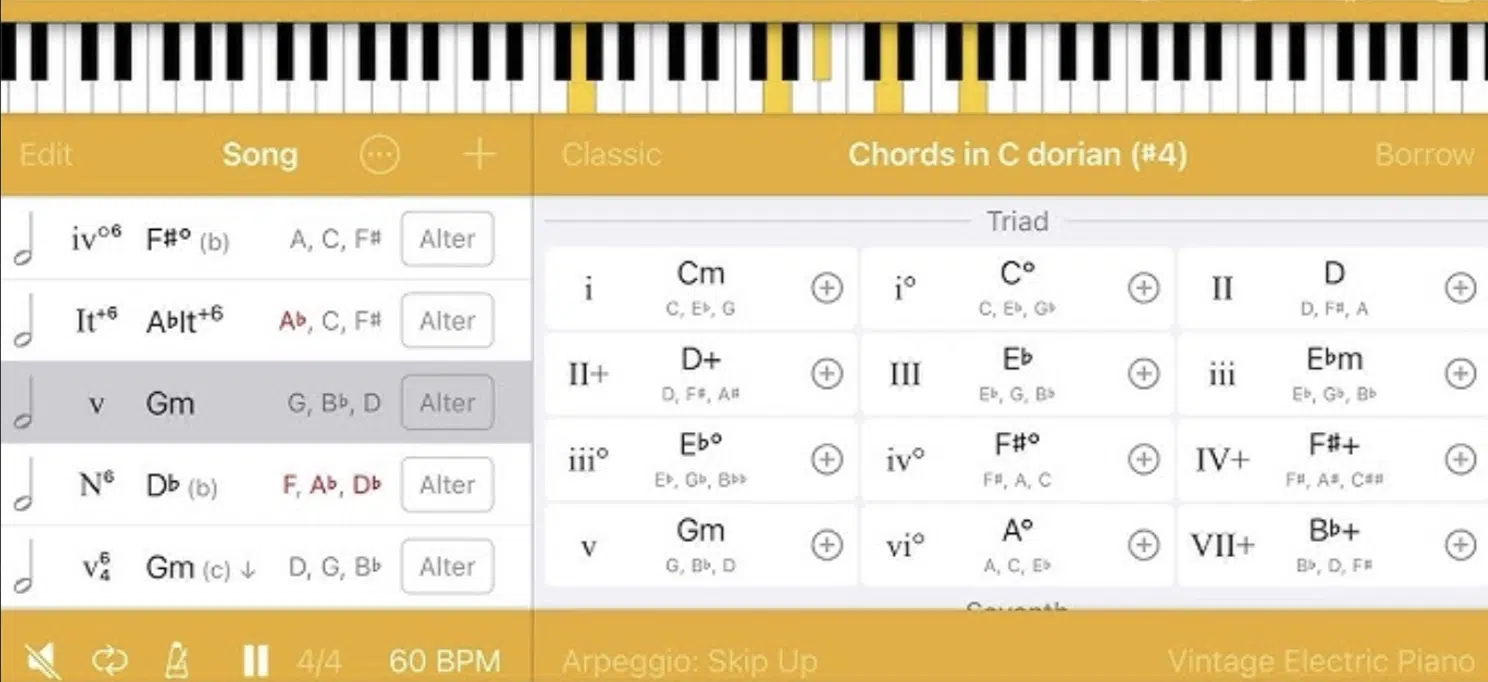
Harmonic layering in the Dorian mode can give your track a rich, full sound that stands out, so start by layering a Dorian chord progression like:
- i – IV – v – IV
- Dm – G – Am – G
Anything to help you really play up that major sixth for a brighter, more radiant feel.
For example, add octaves of D, F, and A in the lower register and use G and B in the higher register to reinforce the Dorian sound.
NOTE: You can use fourth intervals for harmonic layers, such as D-G and F-B because these following intervals fit well with Dorian and give your layers an open, modal quality.
Side note, if you want to learn all about intervals, we got you covered.
You could also experiment with adding dominant chords like A7 to bring a slight tension before resolving back to Dorian.
Try using instruments with different textures: layer a piano playing the white keys and black keys Dm – G – Am – G with synth pads on D – G – A – G to create depth.
If you want more harmonic richness, consider adding seventh chords like Dmin7 and Gmaj7 一 these extra notes enhance the Dorian harmony and fill out the sound.
As a final touch, add some light reverb and delay to the higher layers, making the harmonies more atmospheric while staying true to the Dorian scale.
-
Dorian in Sound Design
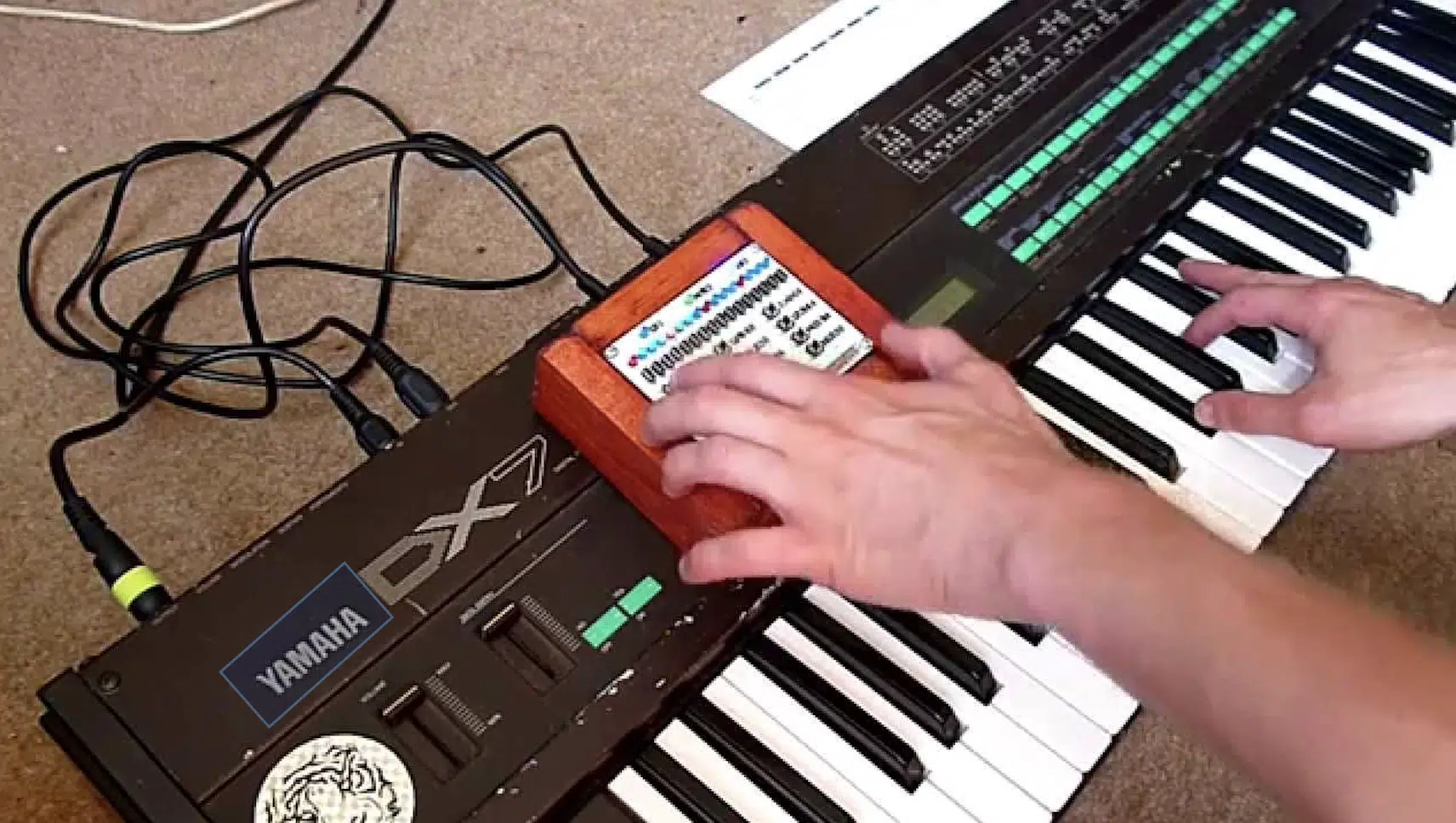
When creating sounds in the Dorian modes, focus on tones that balance the minor dorian quality with an uplifting touch, like B-C-D-E, to keep the sound grounded.
Yet, at the same time, super vibrant and club-worthy even.
To emphasize the Dorian mode sound, try designing a pad that centers around B-C-D-E and shifts to G and A for harmonic interest.
Adding a dominant chord (such as A7) before resolving back to Dcan bring tension, which is especially effective in EDM drops or pop choruses.
NOTE: The Dorian mode is part of the diatonic modes and has roots in medieval theory (hence why it’s also known as the medieval scale), which adds an ancient yet modern feel to your production.
It’s ideal for creating epic, expansive soundscapes.
If you’re layering sounds, experiment with textures that bring out Bb major chords against Dorian harmonies to blend major and minor vibes in a single track.
For trap or hip-hop, consider using B-C-D-E sequences within an arpeggiator, which lets you explore how Dorian modes can expand the melodic range of your beats.
Finally, adding reverb with a long decay time to B and G can amplify the Dorian sound, making your chord progressions feel atmospheric and spacious.
-
Pro Tip

Try adding a slight pitch modulation to your pad sounds, allowing the scale degree nuances to drift, which can enhance the modal feel.
If you’re working with arpeggiators, program it to cycle through Dorian notes (such as D, F, G, A, B, C, and E) to keep the sequence interesting while staying within the Dorian scale.
Lastly, add reverb with a high decay time on the upper harmonics (like B and G) to create space and amplify the Dorian sound’s ethereal quality.
Dorian Mode: Final Thoughts
The Dorian mode is a super versatile tool for adding emotional depth and a touch of brightness to minor tonalities.
It can shift from moody to hopeful, blending minor chords with a distinct major sixth that gives it a unique feel people really react to.
Plus, as you now know, the Dorian mode can bring new life to your tracks by adding grooves and soulful undertones, regardless of what genre you’re working with.
And now, with the new tips and tricks you’ve learned today, you’ll be able to lay down killer melodies, basslines, and chord progressions like a true professional.
To dive even deeper into the Dorian mode and explore its full potential, this Dorian (Medieval) Advanced Scales MIDI Collection is an invaluable resource.
It includes over 1,100 MIDI files of Dorian scales, chord progressions, and melodies designed specifically to help you master the Dorian modes like a boss.
It’s packed with MIDI sequences for every Dorian mode, so you can easily drag and drop these into your DAW to create leads, pads, plucks, and more that truly stand out.
This collection not only saves you time but also lets you bypass complex music theory, giving you access to high-quality Dorian harmonies in your projects instantly.
So, now that you’ve explored everything from Dorian formulas to advanced sound design techniques, go play around with the Dorian mode yourself.
With these tools at your fingertips, you’ll be able to add emotional layers to your tracks and bring a fresh perspective to your minor arrangements to blow the competition away.
Until next time…







Leave a Reply
You must belogged in to post a comment.